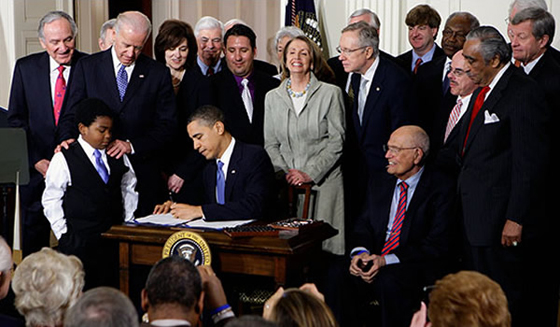Regulation Nation
I’ll bet if you walked up to 100 people on the street and asked, “What is the Federal Register?,” very few, if any, would be able to correctly answer. Yet the Federal Register, often called simply the “FR,” is so completely intertwined with daily living in America that it is arguably the most important publication in the country.
The Federal Register is the place where all proposed and final regulations of the federal government are catalogued and published. If you want a hard copy of the 2013 Federal Register for your personal library, you’ll need to make space for volumes totaling close to 80,000 pages – up 76 percent since 1986. You can order an annual subscription to the Federal Register from the Government Printing Office for a mere $929.
When you hear complaints about over-regulation, it’s not just political posturing or self-interested grumbling from greedy business owners trying to get away with something. The federal government is producing a staggering volume of regulation. In the past 10 years, the number of regulations issued by federal agencies has outnumbered laws passed by Congress by 223 to one. And that’s before Obamacare.
As of now, there are 4,062 new regulations in various stages of implementation.
In the 20th century, America became strong because entrepreneurs and dreamers and the occasional crackpot enjoyed wide latitude to try things. When the Federal Register was first published in 1936, it contained a mere 2,600 pages. Since then, the U.S. economy has grown by a factor of 12 (in constant dollars) while the Federal Register has grown by a factor of 30.
The permanent federal bureaucracy – that part of the government that never faces the voters and is so entrenched as to be beyond the effective sanction of either the president or the Congress – cranks out rules in such volume that literally no one can keep up. In almost all cases, regulations have the force of law. Most federal agencies have their own police forces dedicated to enforcing the regulations that those agencies promulgate.
It is not unheard of for a regulation issued by one federal agency to be 180 degrees at odds with a regulation issued by some other federal agency.
Let me disclaim by saying that I recognize that regulations are necessary. Every game needs a set of rules and a referee otherwise there would be only chaos. But any good referee or umpire will tell you that the goal ultimately is to let the players play the game. Enact too many rules, or be too quick to throw a flag or blow the whistle, and the game becomes so rigid that no one will want to play.
So it is with regulation. The problem is not so much what a new regulation does to existing enterprise – although the cost of regulation falls disproportionately on small businesses. The problem lies more in the suffocating effect that heavy regulation has on innovation. Regulations don’t so much kill as prevent conception.
The last time the Federal Register contracted was during the Reagan administration, when the number of pages in the FR shrank by 31 percent. During that respite from regulatory expansion, the U.S. economy began its longest and most robust expansion in our nation’s history.
By way of contrast, today we have 12 million unemployed, another eight million under-employed and the most anemic post-recession recovery since we started keeping records.
Every time some bureaucrat writes a new rule to go with the thousands upon thousands of existing rules, the arteries of enterprise and commerce become incrementally more sclerotic and incrementally less capable of carrying economic vitality to every household in every corner of the continent.
The nation’s regulatory burden stands at an all-time high. Employment, expressed as the percentage of working-age Americans holding fulltime jobs, stands at an all time low.
That is not mere coincidence.









I was going to write a column on regulation for Opinion Arlington. Now I’ll just run your column (I have Paul’s OK to do so) given that it beats anything I could write! This is another excellent piece.
I think the outrageous growth of the Federal Register is a perfect barometer of the suffocation of Liberty and Free Enterprise (as defined by the Constitution) in favor of the inexorable march of the autocratic state as successfully executed by the Socialists who hide behind “benevolence” as they slowly obtain dictatorial power over each citizen.
But why do they do this? The answer is: Their “faith” in their megalomaniac view of their omnipotent wisdom (that overcomes any competing belief that threatens their “divine-right-of-rule” over the American people), is paramount and shall not be infringed.
excellent piece & two great answers. I couldn’t improve.
Its called “incrementalism”.
Well meaning people try to help & they end up having this ‘creeping socialism’.
Paul,
You are correct that “The Federal Register is the place where all proposed and final regulations of the federal government are cataloged and published.” Before any new federal rule can be finalized, the agency proposing the rule must have it published in the register which is approaching 80,000 pages.
The size of the Code of Federal Regulations (CFR) provides a second yardstick of regulatory activity. Unlike the Federal Register, which is a catalog of regulatory changes, the CFR is a compendium of all existing regulations and is approaching 200,000 pages in length.
Obama-un-Care regulations and the proposed Democrat Amnesty bill (a. k. a., undocumented Democrat voter path to citizenship bill) if passed, will no doubt be adding tens of thousands of additional pages to the CFR.
What does this mean? The bureaucracy of the Federal government has become our masters. The CFR is their bible and they are the Priests of the Church-of-Intimidation by edict on the mountains of regulations that NO ONE can possibly comprehend, understand, or obey.
The strangulation of the nation’s Liberty and dismantling of the Constitution is at hand. The Constitution is being replaced by an autocratic dictatorship that is more powerful than Congress which refuses to correct or control the power of the administrative state. Therefore, the Constitution (that formed our Representative Republic which demands that the government be subservient to the people), is no longer the supreme law of the land.
Is the Liberal Democrat Socialist that has supported the creation of this monstrosity of Federal Regulations going to wake up when his child can not be treated for an illness until the Doctor gets approval from the appropriate regulatory agency that must grant him authority and method to do so? I doubt it!
The progressive left has been at this incremental degradation of freedom for a LONG time. Which begs the question – Is it the fault of the leadership or that of the people who continue to vote for them and keep them in ever increasing power? In my opinion, we the people have abdicated self governance to whomever makes the biggest promise of handouts and support. We have failed to recognize the trap of dependence we have bargained for. Regulations, executive orders, and even congressional bills have been the tools of tyrrany. But we have turned a blind eye and passed on our responsibility to guard the republic and our freedom.
We have nobody to blame but ourselves. WE vote the decision makers in, and when they make the wrong decisions, we don’t vote them out. We have allowed them to slowly erode our freedom because small bites don’t hurt us as much as something gnawing big chunks out of us at one time, but eventually even with small bites the whole is consumed. Thus, goes our freedoms.